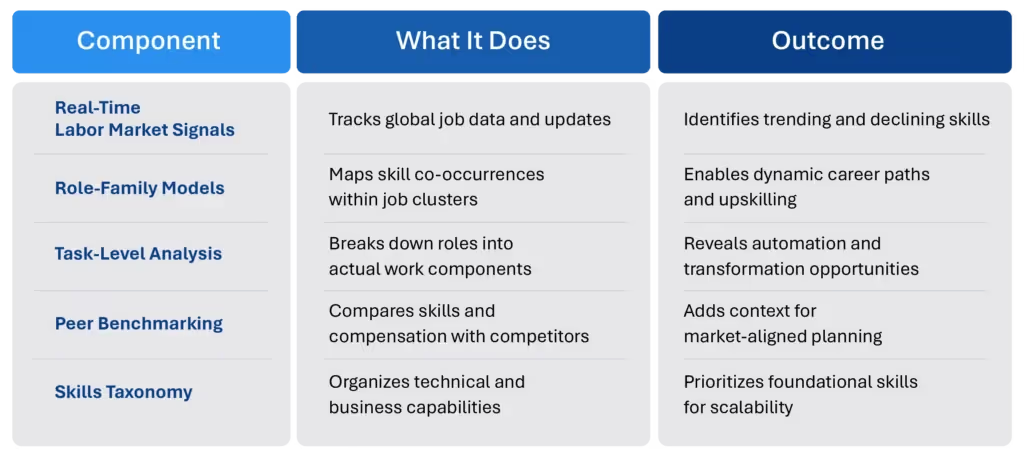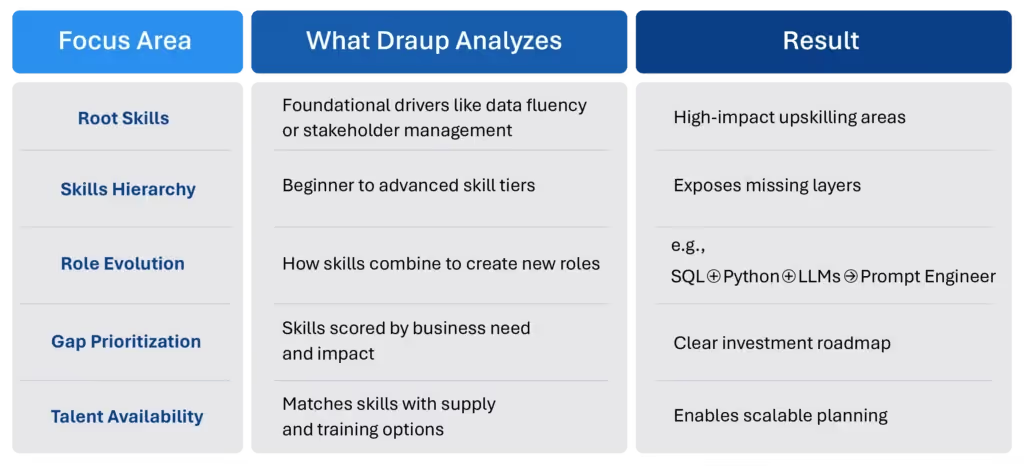Rethinking Skills for AI with Draup’s Data-Rich Talent Intelligence Platform
AI investment is surging, but there’s a catch. Nearly three out of four companies say they’re struggling to find the talent to match their ambitions. The reason? It’s not just a pipeline problem; it’s a perception one. Most organizations still see skills as frozen-in-time checklists, blind to how roles and tasks actually evolve on the ground. That kind of static thinking creates workforce strategies that are outdated the moment they’re written.
Draup offers a different lens.
At the heart of Draup’s Talent Intelligence Platform is a dynamic, role-aware skills architecture designed not just to map the present, but to predict and shape the future of work. It’s built to help organizations not only see what’s changing but also act on it.
How Draup’s Talent Intelligence Platform Powers Skills Architecture
Rather than treat skills as disconnected dots, Draup’s skills architecture weaves together five powerful layers of intelligence.

The result is a living blueprint of your workforce capabilities developed by Draup’s Talent Intelligence Platform that is always evolving, always actionable.
Uncover Skill Clusters with Talent Intelligence Platform
What if you stopped mapping job roles the old-fashioned way and started thinking in terms of dynamic skill clusters?
Draup’s Talent Intelligence Platform analyzes millions of resumes, job descriptions, and market signals to identify groups of skills that naturally function together. These aren’t theoretical groupings, they reflect real-world, high-impact role evolution.
Example: AI-Driven Data Roles
- Core Tech: Python, BigQuery, Spark, SQL
- AI Tools: AutoML, Explainable AI
- Visualization: Power BI, Tableau
- Domain Fluency: EMR systems, compliance protocols
Why does this matter? Because identifying patterns like these lets organizations:
- Spot reskilling opportunities within adjacent roles
- Design career mobility paths based on real transitions
- Build cross-training programs that boost agility across teams
These clusters aren’t static; they flex as demand evolves, keeping your workforce aligned with what’s next.
Focus on Root Skills that Drive Transformation
Beyond clusters lie the root systems, foundational skills that fuel transformation across domains.

Draup’s Talent Intelligence Platform zeroes in on these “root skills” to help HR leaders prioritize upskilling where it will matter most. Whether it’s cloud fluency, data literacy, or critical thinking, these capabilities form the bedrock of an AI-enabled enterprise.
Apply an AI-Ready Maturity Model
Knowing what skills you have is useful. Knowing when they matter is essential.
The AI-Ready Maturity Model in Draup’s Talent Intelligence Platform maps your skill inventory across four stages: Traditional → Disrupted → Emerging → Future-Emerging
This lets you chart transformation logically, no guesswork, no wasted training dollars.
Example Progressions:
- Technical Path: SQL → Python → LLM Pipelines
- Analytical Path: Reporting → Predictive Analytics → Decision Intelligence
- Operational Path: Manual Tasks → Cloud Tools → AI-Driven Workflows
This kind of sequencing by Draup’s talent intelligence platform helps you:
- Direct upskilling to the right teams at the right time
- Align learning pathways with organizational goals
- Prepare people to move into future-ready roles, confidently
Benchmark Against Your Competitive Ecosystem
AI readiness isn’t just an internal game. You need to know how your capabilities stack up across your competitive landscape.

Draup’s peer intelligence engine benchmarks your roles, skills, and compensation models against market leaders. Are you underinvesting in key AI functions? Losing ground on emerging tech roles? The answers lie in the data.
Reimagine Roles at the Task Level
To embed AI into the heart of your business, you can’t just rename roles, you need to redesign them.
Draup’s Talent Intelligence Platform breaks roles down into tasks, helping you identify where AI can step in and where human skill remains irreplaceable. For example:
- Training AI models? Automatable.
- Validating outputs in a regulated domain? Still needs human oversight.
This level of task-level clarity ensures AI and human expertise coexist by design, not by default.
Draup’s Talent Intelligence Platform transforms your workforce strategy from a static org chart to a dynamic, data-rich map of what’s possible. It doesn’t just show you the gap between where you are and where you need to be; it helps you build the bridge, one skill cluster, root capability, and task-level insight at a time.
Redefine skills with precision. Build transformation that lasts.
Want to go deeper? Listen to the podcast: How Draup Is Expanding the World of Talent Intelligence.










.svg)
















.svg)





.svg)





.svg)
